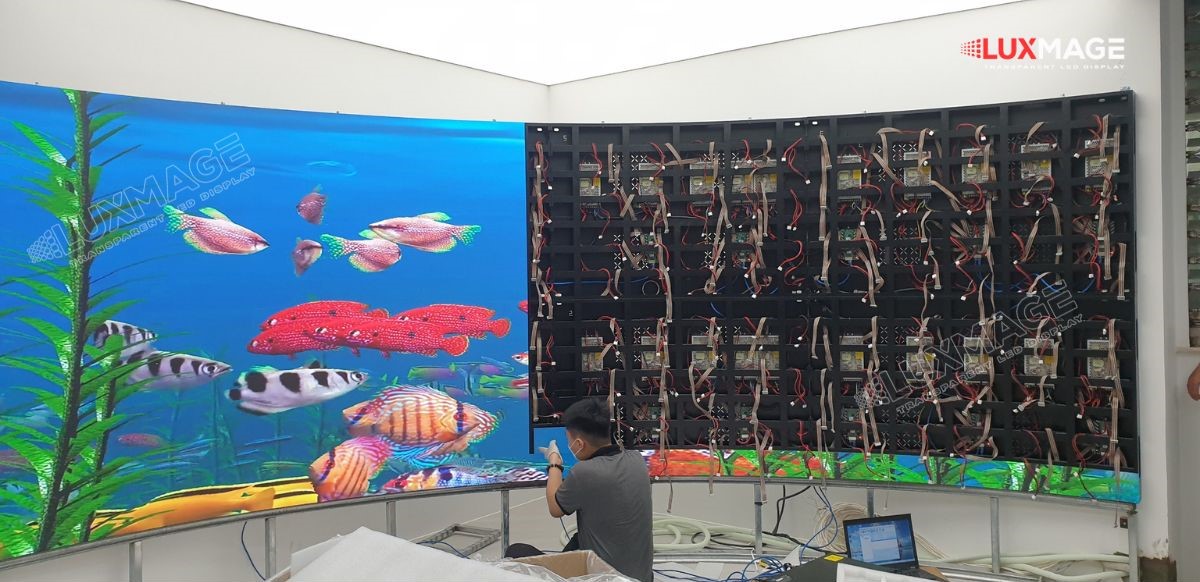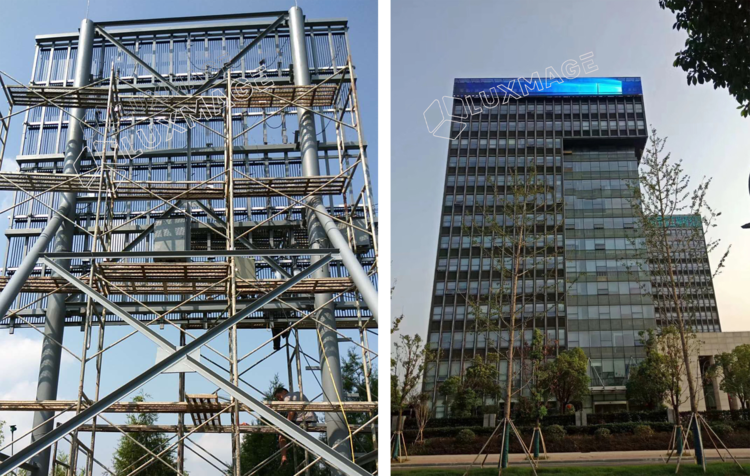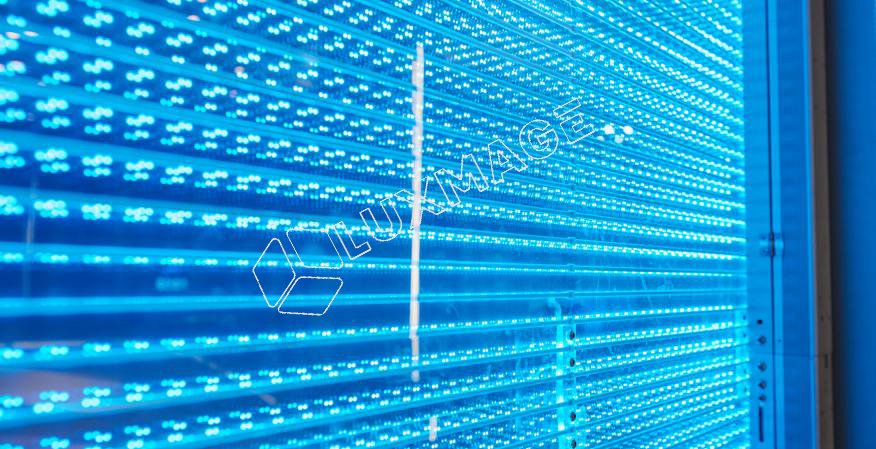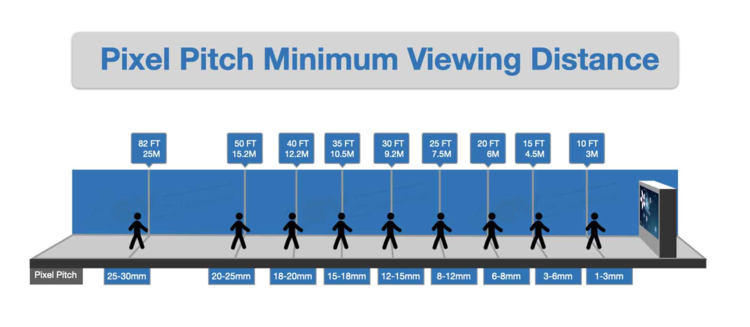Transparent LED screens are becoming more and more popular and appearing in many diverse locations such as shopping centers, schools, hospitals, restaurants, agencies, businesses, etc. This is not only due to its advantages. but also because of their ability to flexibly serve many different fields. However, the important issue is how to carry out the LED screen installation process in a way that meets technical standards and saves costs. Let's follow luxmage to see how the LED screen installation process goes!

Before starting the LED screen construction and installation process, based on the project information provided by the customer, perform the following preparation steps:

2. Preparation before installation:
Before starting the installation work, Luxmage's technical and construction team needs to prepare all materials and tools, including drills, cutting machines, welding machines, laser machines, and materials such as LED Modules. , iron frame, LED source, control card, microprocessor, electrical wire, network cable, and tools such as screwdrivers, pliers,...
The LED screen installation and construction process is carried out in 11 basic steps:
Confirm the system operates stably by testing the content for 8 - 24 hours, with investor approval.
Check the safety and security of information after the system operates, connect the LED screen to the control center room, and ensure safety and security immediately after successful installation.
Luxmage - a professional unit to perform maintenance and repairs when necessary, ensuring system stability and safety.
Through the detailed steps above, Luxmage is committed to providing customers with quality and effective LED screen installation projects. Don't hesitate to contact us for the most detailed advice and support.
When installing an LED screen, there are many important factors to consider to ensure good performance and user satisfaction. Below are some important factors when installing LED screens.

Resolution: Choose a resolution suitable for your intended use. The higher the resolution, the more detailed the image will be, but also comes with a higher cost.
Pixel Pitch: Pixel pitch represents the distance between pixels on the screen. Smaller pixel pitch produces sharper images, especially important when the viewer is close to the screen.
Control system: Choose the management and control system that suits your needs and desired features. The system should support common input signals and have flexible control capabilities.
Connectivity and integration: Ensure good integration with different systems such as computers, cameras, or other devices.
Installation location: Determine the installation location so that the screen can be seen clearly from different angles. At the same time, consider surroundings such as environmental lighting and obstructions.
Viewing angle: Choose a viewing angle so everyone in the area can see the image without losing quality.
Safety and regulatory compliance
Safety: Ensure that the installation complies with safety standards. This includes ensuring there are no electrical risks and a level of safety for users.
Regulatory Compliance: Check and ensure compliance with regulations and laws related to the use and installation of LED displays.
These elements together create an effective LED screen system that is suitable for specific usage needs.
Resolution, or the total number of pixels on the screen, determines the amount of detail displayed. For LED screens, HD resolution (1024x768) is usually enough for good quality. However, each project has different requirements. The higher the resolution, the sharper the image, but the price also increases. For example, P2 has better detail than P2.5, P2.5 is sharper than P3.0, and so on.
The higher the brightness, the better the display. For outdoor screens, brightness is usually from 4,000-5000CD/m2, indoor is 600-1000CD/m2. Remember that the higher the brightness, the higher the cost.
To achieve maximum performance from an LED screen, choosing the right type for the intended use is important. This not only ensures good image quality but also saves costs and optimizes the viewer experience. The purpose of using LED screens is specifically divided as follows:
The process of consulting on installation and choosing the right LED display type will ensure that each application has the best display experience based on its specific requirements.
Brightness and waterproof level
Brightness: Determine the required brightness based on the usage environment. Outdoor screens need to have higher brightness than indoor screens.
Water Resistant: For outdoor displays, make sure the display has a waterproof rating to protect against the elements.
LED screen lifespan
Before deciding to install a product, one of the top concerns is the product's shelf life, and this also applies to transparent LED products. Data from manufacturers generally indicates that transparent LEDs can operate for approximately 100,000 hours, equivalent to more than 11 years of use. However, it should be noted that this number is usually given under ideal testing conditions, such as in a laboratory.
Actual data from usage surveys generally shows that the effective operating time of the product is about 9-10 years, which is about 87,600 hours. This is because in real life conditions, the lifespan of transparent LEDs can be affected by many factors both internally and externally. So, what are the factors that affect the longevity of this product line?
Simple and routine operation and maintenance. Instructions will be provided after purchasing the LED display. Warranty is usually 12-24 months, and maintenance costs after this period are usually about 3% of the installation cost per year.
Select the appropriate P (Pixel Pitch).

The intended use determines the type of LED screen. For example: P2.0, P2.5, P3.0 for indoor showroom; P3.0, P3.91, P4.0 for outdoor advertising; P3.0, P3.91, P4.0 Indoor for stages and halls; P5, P6, P10 run text; P1.5, P1.86, P2.0 for meeting rooms with high resolution.
When installing LED screens, many people often have questions to ensure the process goes smoothly and meets their needs. Below are some frequently asked questions during LED screen installation:
Transparent LED screen with flexibility and diversity, can be installed in many different locations to serve diverse purposes. From shopping malls, schools, and hospitals, to restaurants, corporate offices, and stadiums, LED screens are not only information display tools but also increase aesthetic value and interactivity. work. Thereby, they create unique visual experiences, attract customers, and meet a variety of community needs in all fields from education, health, to entertainment and business.
To choose the right LED screen size, measure the actual size of the display area and determine the appropriate aspect ratio, pixel pitch, and resolution. Consider viewer location, intended use, and lighting conditions. This helps ensure the screen is not too large or too small, reflects your needs and ensures optimal performance within budget.
The daytime transparent LED screen reaches 6000cd, ensuring clear display under the sun. A special feature is that the ability to adjust the lighting of this type of LED allows to optimize performance, especially at night when the brightness can be flexibly adjusted to suit the environment. The brightness of the LED screen needs to be sufficient to display clearly under ambient light, especially when installed outdoors.
Special backgrounds such as color and material can affect the display effect of LED screens, so appropriate background design needs to be considered.
The cooling system needs to be ensured to avoid overheating, causing damage to the screen and internal components.
To effectively maintain and repair LED screens, routine care is the key to keeping the device operating stably and durable. This includes checking the LEDs, electronic circuitry, and connections, and keeping the screen surface clean. In the event of a problem, prompt repair and replacement of damaged components is important to ensure image quality and longevity of the display. For complex work, seeking support from a professional unit is an important step to protect not only the equipment but also the safety of users.
Determine whether it is necessary to adjust settings such as brightness or color over time to maintain display quality.
Installation location and viewing angle need to be considered to ensure every viewer has the best experience.
For large projects, maintenance costs after the warranty expires need to be estimated to determine the long-term budget.
These questions help define the specific requirements and criteria of the project, while also supporting the process of installing and maintaining the LED screen effectively.
.jpg)
Investing in LED screen installation requires a large initial budget, so deciding to choose an LED screen with long life and quality components is the top factor you need to consider. At the same time, finding a professional and reputable construction unit in product warranty and maintenance is also very important.
Luxmage, with many years of experience in constructing and installing LED screens, is a reliable partner with many large and small projects. We are committed to ensuring the quality of indoor and outdoor LED screen products, which have been used and appreciated by many partners over time. With a reputation as a leading LED screen construction and installation unit, we look forward to cooperating to bring customers many quality products.
In many cases, installing LED screens to serve businesses requires a large cost and is not flexible with diverse size requirements. For short-term use needs, Luxmage has an additional LED screen rental service to help customers be more flexible and cost-effective. If you have any questions or need advice, please contact Luxmage immediately for immediate treatment!
Vi Luc Technology Co., Ltd. - LUXMAGE
Address: 80, Street 9, Ward 9, Go Vap District, City. HCM
Hotline: 0988.895.066
Email: sale@luxmage.com
Hot news
Posted by: marketingluxmage - Date: 22-11-2023
Last Page: GENUINE ADVERTISING LED SCREEN | DETAILED QUOTES
Next Page: LED SCREEN FOR WEDDINGS AND RESTAURANTS | QUICK CONSTRUCTION AND INSTALLATION
- Digital Showroom | A Solution to Elevate Modern Corporate Exhibition Spaces
- Indoor COB LED Display | Premium Display Solution for Building Lobbies
- P1.53 & P1.86 Floor-Standing LED Display | A Modern In-Store Display Solution
